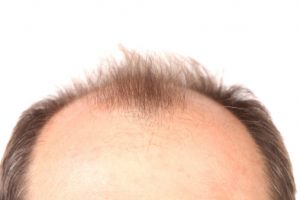
Senior author Michael B. Cook said, “Our study found an increased risk for aggressive prostate cancer only in men with a very specific pattern of hair loss, baldness at the front and moderate hair-thinning on the crown of the head, at the age of 45. But we saw no increased risk for any form of prostate cancer in men with other hair-loss patterns. While our data show a strong possibility for a link between the development of baldness and aggressive prostate cancer, it’s too soon to apply these findings to patient care.”
The researchers examined male pattern baldness and the risk of prostate cancer in 39,070 men from the U.S. PLCO Cancer Screening Trial, aged 55 to 74 upon enrollment. The men answered questions to recall their balding patterns – especially at the age of 45 – using a pictorial tool.
During follow-up, 1,138 prostate cancer cases were diagnosed, and the mean age was 72.
Frontal and crown balding was associated with 40 percent higher risk of prostate cancer development, compared to men who were not balding.
Further research is required to determine the groups at risk of developing prostate cancer, and how detecting male pattern baldness can help with early diagnosis.
Other risk factors for prostate cancer
Although more research has to go into determining the role that male pattern baldness plays in the risk of prostate cancer, there are other known factors that increase a person’s risk.
Age is a large risk factor for prostate cancer, as it is most common in those over the age of 50.
Race has been shown to be a risk factor, too. Prostate cancer has been found to have a higher prevalence among African Americans followed by white men.
Prostate cancer is also influenced by family history. If a man’s father or brother had prostate cancer, his risk goes up as well. If a man has three immediate family members with prostate cancer, his risk goes up 10 times, compared to a man who doesn’t have any close relatives with prostate cancer.
Lastly, like with many diseases, diet has been shown to influence prostate cancer. Studies have found that men who eat high-fat diets have a higher risk of developing prostate cancer, too.
Speak to your doctor about your own risk of prostate cancer and take necessary measurements in order to prevent it as best as possible.
Related Reading:
Prostate cancer patients undergoing ADT experience hot flashes
Prostate cancer patients undergoing androgen deprivation therapy (ADT) experience hot flashes. ADT is a common treatment for prostate cancer in its advanced stage, yet nearly 80 percent of ADT patients experience hot flashes. Researchers from Moffitt Cancer Center looked to explore why the phenomenon may occur and determine genetic factors along with other characteristics that would determine why some men experience hot flashes while on ADT and others do not. Continue reading…
Cardiovascular disease (CVD), metabolic risks linked to ADT in men with prostate cancer
Cardiovascular disease (CVD) and metabolic risks are linked to ADT in men with prostate cancer. Androgen deprivation therapy (ADT) is a treatment for prostate cancer, which is the most common form of cancer in men and is the second leading cause of cancer-related deaths in the U.S. Prostate cancer can be a slow process, but if caught early enough, treatment can more effective. Continue reading…
Sources:
http://www.cancer.gov/types/prostate/understanding-prostate-changes
http://jco.ascopubs.org/content/early/2014/09/15/JCO.2014.55.4279